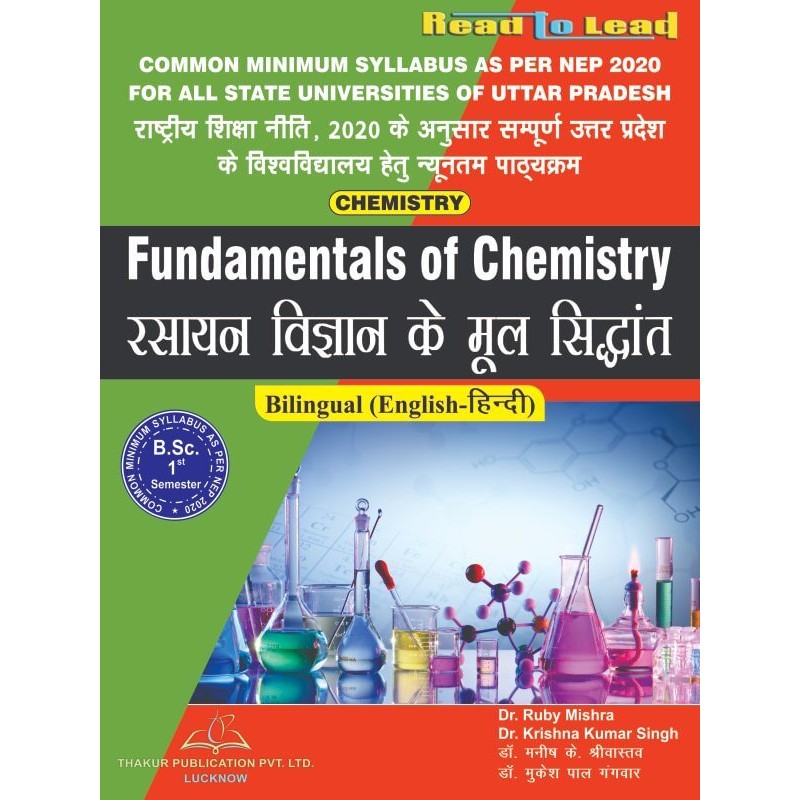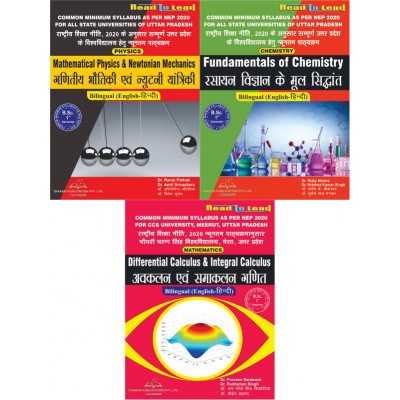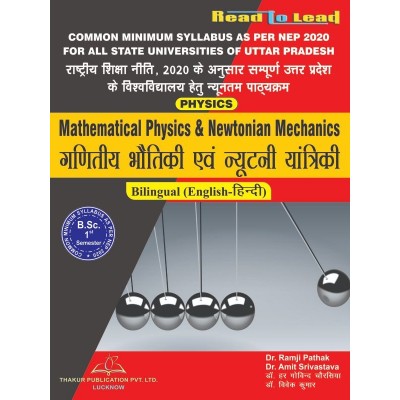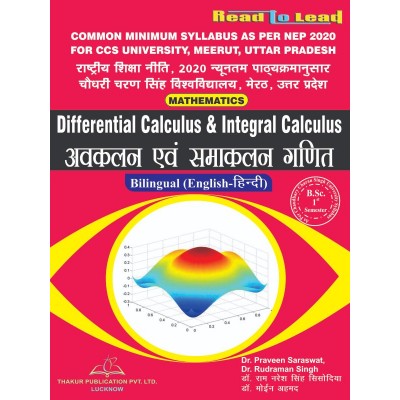Fundamentals Of Chemistry (रसायन विज्ञान के मूल सिद्धांत)
₹470.00
Tax excluded
Click below to Buy E-Book Edition:
₹280 E-BOOK GOOGLE PLAY
We are providing Fundamentals Of Chemistry Book (रसायन विज्ञान के मूल सिद्धांत) For b.Sc 1st semester in U.P nep2020 common minimum syllabus by Thakur Publication.
ISBN- 978-93-5480-174-7
Authors English- Dr. Ruby Mishra, Dr. Krishna Kumar Singh
Hindi Authors- Dr. Manish K. Srivastava, Dr. Mukesh Pal Gangwar
Syllabus
FUNDAMENTALS OF CHEMISTRY
Course Code: B020101T
|
Units |
Topics |
|
I |
Introduction to Indian ancient Chemistry and contribution of Indian Chemists, in context to the holistic development of modern science and technology, should be included under Continues Evaluation (CIE). Molecular Polarity and Weak Chemical Forces: Resonance and resonance energy, formal charge, Van der Waals forces, ion-dipole forces, dipole-dipole interactions, induced dipole interaction, dipole moment and molecular structure (Diatomic and polyatomic molecules), Percentage ionic character from dipole moment, polarising power and polarisability. Fajan’s rules and consequences of polarisation. Hydrogen bonding, Van der Waals forces, ion-dipole forces, dipole-dipole interactions, induced dipole interaction. (10) |
|
II |
Simple Bonding Theories of Molecules: Atomic orbitals, Aufbau principle, multiple bonding (σ and π bond approach) and bond lengths, the Valence Bond Theory (VBT), Concept of hybridisation, hybrid orbitals and molecular geometry, Bent’s rule, Valence Shell Electron Pair Repulsion theory (VSEPR), shapes of the following simple molecules and ions containing lone pairs and bond pairs of electrons: H2O, NH3, PCl5, SF6, SF4, ClF3, I3–, and H3O+. Molecular Orbital Theory (MOT). Molecular orbital diagrams bond orders of homonuclear and heteronuclear diatomic molecules and ions (N2, O2, C2, B2, F2, CO, NO, and theirions)( |
|
III |
Periodic properties of Atoms (with reference to s & p-block): Brief discussion, factors affecting and variation trends of following properties in groups and periods. Effective nuclear charge, shielding or screening effect, Slater rules, atomic and ionic radii, Electronegativity, Pauling’s/Allred Rochow’s scales, ionisation enthalpy, electron gain enthalpy. (05) |
|
IV |
Recapitulation of basics of Organic Chemistry: Hybridisation, bond lengths and bond angles, bond energy, localised and delocalised chemical bonding, Van der Waals interactions, inclusion compounds, clatherates, charge transfer complexes, hyperconjugation, Dipole moment; Electronic Displacements: Inductive, electromeric, resonance mesomeric effects and their applications. (05) |
|
V |
Mechanism of Organic Reactions: Curved arrow notation, drawing electron movements with allows, half-headed and double-headed arrows, homolytic and heterolytic bond fission, Types of reagents – electrophiles and nucleophiles, Types of organic reactions, Energy considerations. Reactive intermediates – carbocations, carbanions, free radicals, carbenes, arynes and nitrenes (with examples). (10) |
|
VI |
Stereochemistry: Concept of isomerism, Types of isomerism; Optical isomerism – elements of symmetry, molecular chirality, enantiomers, stereogenic centre, optical activity, properties of enantiomers, chiral and achiral molecules with two stereogenic centres, diasteromers, threo and erythro diastereomers, meso compounds, resolution of enantiomer, inversion, retention and racemisation. Relative and absolute configuration, sequence rules, D & L and R & S systems of nomenclature. Geometric isomerism – determination of configuration of geometric isomers, E & Z system of nomenclature, geometric isomerism in oximes and alicyclic compounds. Conformational isomerism – conformational analysis of ethane and n-butane; conformations of cyclohexane, axial and equatorial bonds, conformation of monosubstituted cyclohexane derivatives, Newman projection and Sawhorse formulae, Fischer and flying wedge formulae, difference between configuration and conformation. (10) |
|
VII |
Basic Computer System (in brief): Hardware and Software; Input devices, Storage devices, Output devices, Central Processing Unit (Control Unit and Arithmetic Logic Unit); Number system (Binary, Octal and Hexadecimal Operating System); Computer Codes (BCD and ASCII); Numeric/String constants and variables. Operating Systems (DOS, WINDOWS, and Linux); Introduction of Software languages– Low level and High level languages (Machine language, Assembly language; QBASIC, FORTRAN) Software Products (Office, chemsketch, scilab, matlab, hyperchem, etc.), internet application. (05) |
|
VIII |
Mathematical Concepts for ChemistryLogarithmic relations, curve sketching, linear graphs and calculation of slopes, differentiation of functions like Kx, ex, Xn , sinx, logx; maxima and minima, partial differentiation and reciprocity relations, Integration of some useful/relevant functions; permutations and combinations, factorials, probability. (05) |
ikB~;Øe
jlk;u foKku ds ewy fl)kar
Course Code: B020101T
|
bdkbZ |
fo"k; |
|
I |
भारतीय प्राचीन रसायन विज्ञान का परिचय एवं आधुनिक विज्ञान तथा प्रौद्योगिकी के समग्र विकास के संदर्भ में भारतीय रसायनज्ञों के योगदान को सतत मूल्यांकन (सीआईई) के अन्तर्गत शामिल किया जाना चाहिए। vk.kfod èkzqoh;rk ,oa nqcZy jklk;fud cy& अनुनाद एवं अनुनाद ऊर्जा, फाॅर्मल आवेष, वाण्डरवाल्स बल, आयन-द्विध्रुवीय बल, द्विध्रुवीय-द्विध्रुवीय अंतःक्रियाएं, प्रेरित द्विध्रुवीय अंतःक्रिया, द्विध्रुवीय आघूर्ण एवं आणविक संरचना (द्विपरमाणुक तथा बहुपरमाणुक अणु), प्रतिशत से आयनिक लक्षण द्विध्रुवीय आघूर्ण, ध्रुवीकरण शक्ति एवं ध्रुवीकरण। फजान के नियम और ध्रुवीकरण के परिणाम। हाइड्रोजन बन्ध, वाण्डरवाल्स बल, आयन-द्विध्रुवीय बल, द्विध्रुव-द्विध्रुव अंतःक्रियाएं, प्रेरित द्विध्रुव अन्योन्यक्रिया। (10) |
|
II |
v.kqvksa ds ljy caèk fl)kar& परमाणु कक्षक, ऑफबाऊ नियम, एकाधिक बंधन (σ और π बन्ध दृष्टिकोण) तथा बन्ध लम्बाई, संयोजकता बन्ध सिद्धांत (वीबीटी), संकरण की अवधारणा, संकर कक्षक एवं आणविक ज्यामिति, बेन्ट के नियम, संयोजकता कोश इलेक्ट्रॉन युगल प्रतिकर्षण सिद्धांत (वीण्एसण्ईण्पीण्आर), निम्नलिखित सरल अणुओं तथा आयनों के आकार जिनमें एकाकी युगल एवं इलेक्ट्रॉनों के बन्ध युगल होते हैंः भ्2व्ए छभ्3ए च्ब्स5ए ैथ्6ए ैथ्4ए ब्सथ्3ए प्3दृए और भ्3व़्। आणविक कक्षक सिद्धांत (एमओटी)। आणविक कक्षक आरेख होमोन्यूक्लियर और हेटेरोन्यूक्लियर द्विपरमाणुक अणु एवं आयनों ( छ2ए व्2ए ब्2ए ठ2ए थ्2ए ब्व्ए छव्ए और उनके आयनों) के आबंध क्रम। |
|
III |
ijek.kqvksa ds vkorÊ xq.k ¼s ,oa p-Cy‚d ds lanHkZ esa½& संक्षिप्त चर्चा, समूहों एवं आवर्त में निम्नलिखित गुणों को प्रभावित करने वाले कारक और भिन्नता प्रवृति। प्रभावी नाभिकीय आवेष परिरक्षण या स्क्रीनिंग प्रभाव, स्लेटर नियम, परमाणु तथा आयनिक त्रिज्या, विद्युतऋणात्मकता, पॉलिंग/आलरेड राॅसकाॅष के स्केल, आयनीकरण एन्थैल्पी, इलेक्ट्रॉन लाभ एन्थैल्पी। (05) |
|
IV |
dkcZfud jlk;u foKku ds ewy rRoksa dk lkj& ladj.k] vkcUèk yEckà ,oa cUèk dks.k] cUèk ÅtkZ] LFkkuh;—r rFkk foLFkkfur jklk;fud cUèk] ok.MjokYl var%fØ;k] lekos'ku ;kSfxd] DySFkjsV] vkos'k LFkkukUrj.k ladqy] vfrla;qXeu] f}èkzqo vk?kw.kZ( bysDVª‚fud foLFkkiu% çsjd] bysDVªksesfjd] vuqukn eslksesfjd çHkko rFkk muds vuqç;ksxA (05) |
|
V |
dkcZfud vfHkfØ;kvksa dh fØ;kfofèk& वक्रित तीर संकेतन, अनुमति के साथ इलेक्ट्रॉन गतिविधियों को चित्रित करना, अर्ध-षीर्ष वाले एवं दो-षीर्ष वाले तीर, होमोलिटिक एवं हेटेरोलिटिक बन्ध विखंडन, अभिकर्मकों के प्रकार - इलेक्ट्रोफाइल तथा न्यूक्लियोफाइल, कार्बनिक अभिक्रियाओं के प्रकार, ऊर्जा विचार। अभिक्रियाशील मध्यवर्ती - कार्बोधनायन, कार्बेनियन, मुक्त मूलक, कार्बीन्स, एरीन्स और नाइट्रिन (उदाहरण के साथ) (10) |
|
VI |
f=foe jlk;u& समावयवता की अवधारणा, समावयवता के प्रकार; प्रकाशिक समावयवता- समरूपता के तत्व, आणविक किरेलिटी, प्रतिबिंबरूपता, स्टीरियोजेनिक केन्द्रक, प्रकाशिक गतिविधि, प्रतिबिंबरूपता के गुण, दो स्टीरियोजेनिक केन्द्रों के साथ किरेल एवं अकिरेल अणु, डायस्टीरियोमर, थ्रिओ एवं एरिथ्रो डायस्टीरियोमर, मेसो यौगिक, प्रतिबिंबरूपता का विभेदन, व्युत्क्रम, प्रतिधारण और रैसिमिकीकरण सापेक्ष तथा निरपेक्ष विन्यास, अनुक्रम नियम, नामतंत्र के क् - स् और त् - ै प्रणाली। ज्यामितीय समावयवता - ज्यामितीय समावयवों के विन्यास का निर्धारण, नामकरण की म् र्- प्रणाली, ऑक्सिम तथा ऐलिसाइक्लिक यौगिकों में ज्यामितीय समावयवता। गठनात्मक समरूपता - ईथेन और एन-ब्यूटेन का गठनात्मक विश्लेषण; साइक्लोहेक्सेन, अक्षीय और विषुवतीय बन्धों के अनुरूपण, मोनोसबस्टिट्यूटेड साइक्लोहेक्सेन व्युत्पन्न की रचना, न्यूमैन प्रोजेक्शन एवं सॉहोर्स सूत्रों, फिशर तथा फ्लाइंग वेज सूत्रों, संरूपण एवं अनुरूपता के बीच अंतर (10) |
|
VII |
ewy daI;wVj ç.kkyh ¼la{ksi esa½& हार्डवेयर एवं सॉफ्टवेयर; इनपुट डिवाइस, स्टोरेज डिवाइस, आउटपुट डिवाइस, केंद्रीय प्रक्रिया इकाई ( नियंत्रण यूनिट एवं अरिथमेटिक लॉजिक यूनिट); संख्या प्रणाली (बाइनरी, ऑक्टल और हेक्साडेसिमल ऑपरेटिंग सिस्टम); कंप्यूटर कोड (ठब्क् तथा ।ैब्प्प्); संख्यात्मक/सिं्ट्रग स्थिरांक एवं चर। ऑपरेटिंग सिस्टम (डॉस, विन्डोज़, एवं लिनक्स); सॉफ्टवेयर भाषाओं का परिचय- निम्न स्तर और उच्च स्तरीय भाषाएं (मशीन भाषा, असेंबली भाषा; फठ।ैप्ब्ए थ्व्त्ज्त्।छद्ध सॉफ्टवेयर उत्पाद (आॅफिस केमस्केच, साइलैब, मैटलैब, हाइपरकेम, आदि), इंटरनेट एप्लिकेशन । (05) |
|
VIII |
jlk;u foKku ds fy, xf.krh; voèkkj.kk,¡ लघुगणक सम्बन्ध, वक्र रेखाचित्र, रैखिक रेखांकन एवं ढाल/स्लोप की गणना, ज्ञगए मगए ग्द ए ेपदगए सवहग जैसे कार्यों का अवलकन; उच्चतम एवं न्यूनतम, आंशिक अवलकन तथा पारस्परिक सम्बन्ध, कुछ उपयोगी/प्रासंगिक कार्यों का एकीकरण; क्रमपरिवर्तन और संयोजन, कारकीय, संभाव्यता। (05) |
UP State2022/ B.sc(Bilingual)/1/03
50 Items
New
3 other products in the same category:
Comments (0)
No customer reviews for the moment.













